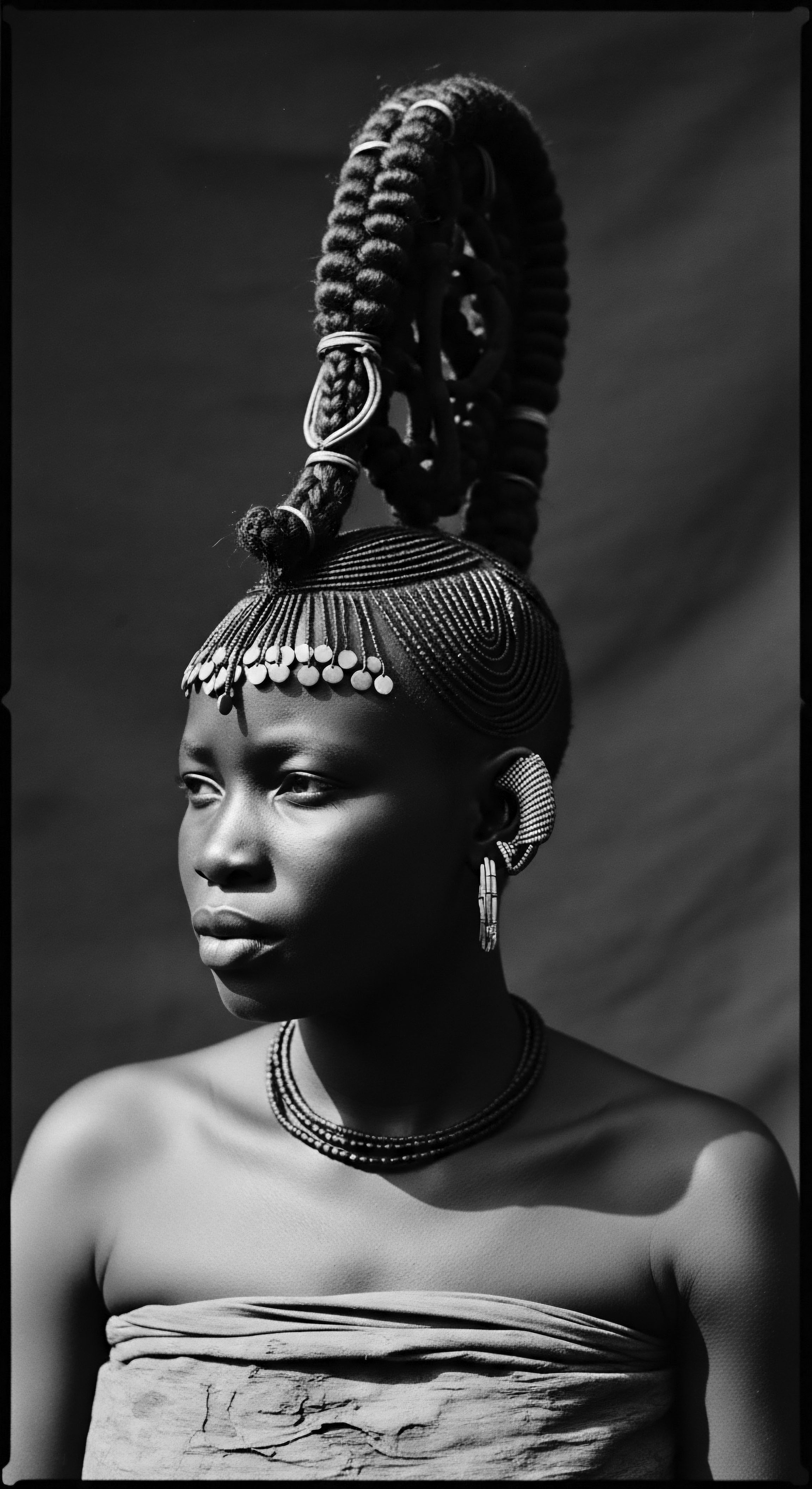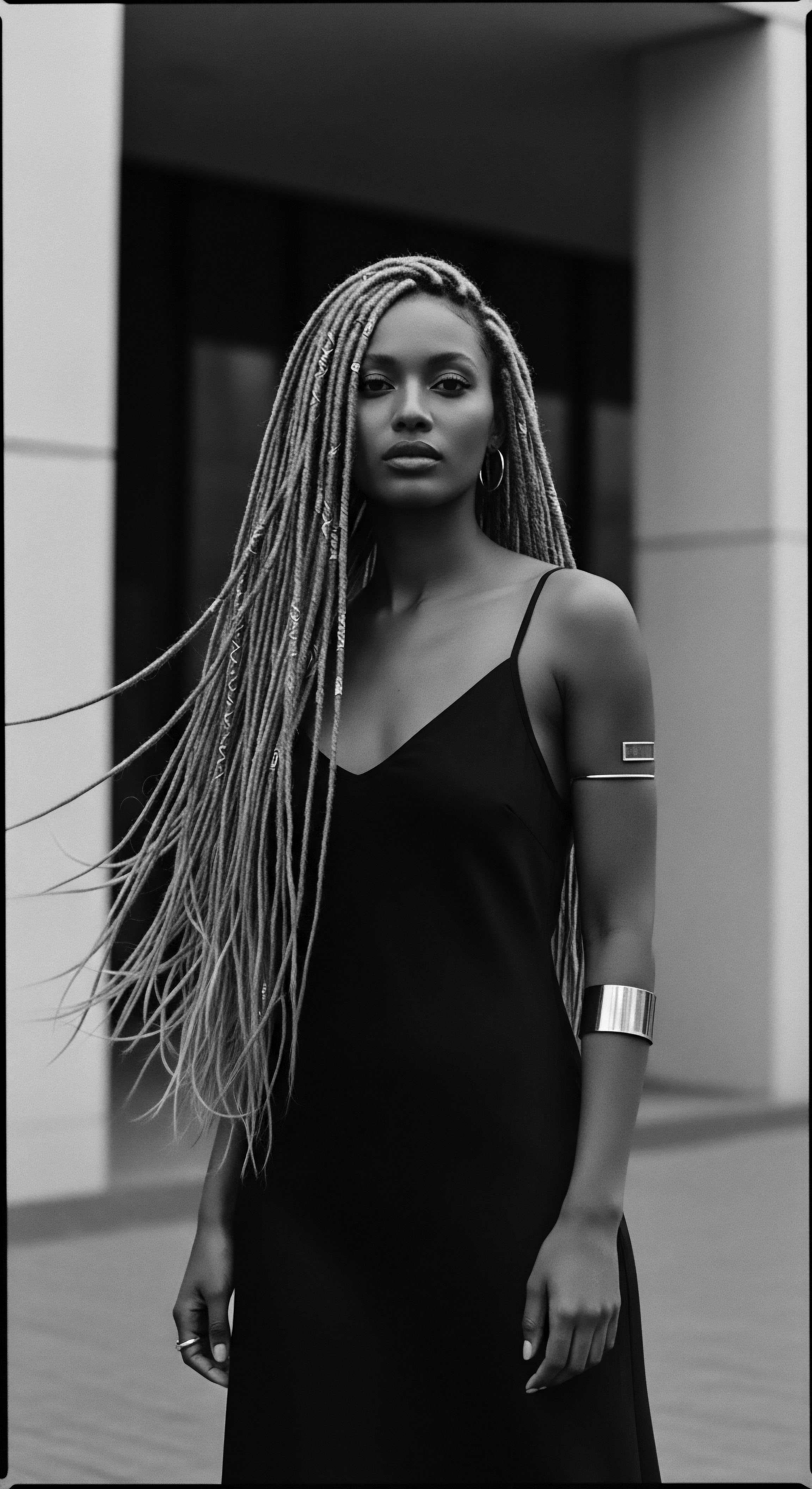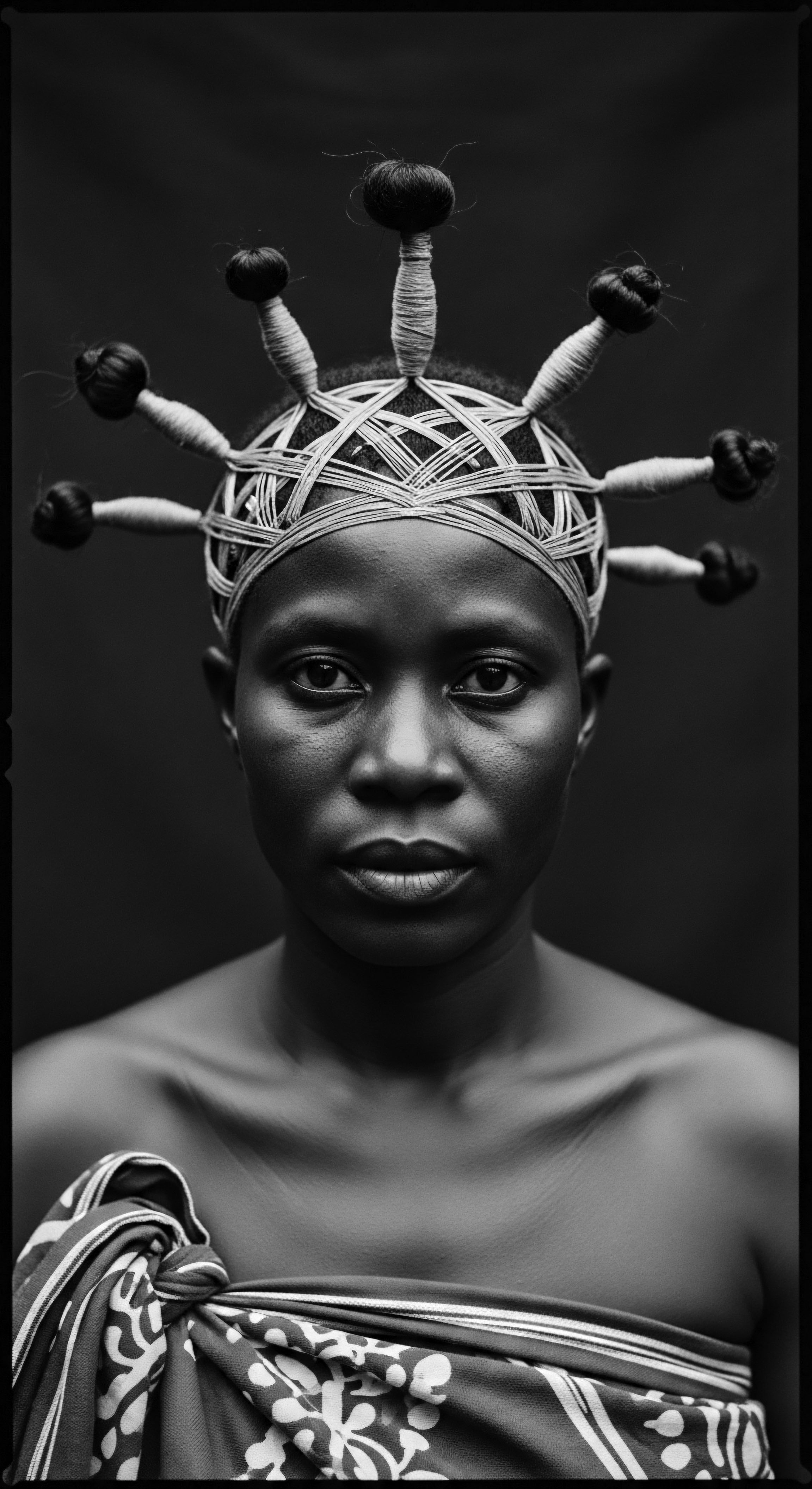
Fundamentals
The Tignon Law, enacted in Spanish colonial Louisiana during 1786, stands as a poignant historical decree, an early attempt to control the visible identity of free women of color. This legislation mandated that women of African descent, whether enslaved or free, publicly conceal their hair with a head covering, known as a tignon. The fundamental intent behind this regulation was to visually differentiate these women from their white counterparts, particularly those whose elaborate hairstyles and vibrant presentation were seen as challenging the prevailing social hierarchy. It served as a means to mark and define, attempting to impose a clear visual signifier of subordinate status within a society grappling with complex racial and class distinctions.
At its core, the Tignon Law represented a deliberate act of social engineering, aiming to enforce a particular understanding of racial order through outward appearance. The term ‘tignon’ itself, a derivative of the French word ‘chignon’ (referring to a hair bun), underscores the direct connection to hair, specifically textured hair, which was often styled in intricate ways reflective of rich ancestral traditions. This law was not merely about modesty or dress code; it was a profound statement about power, control, and the policing of Black and mixed-race bodies and their expressive forms. It sought to strip away a visible marker of personal and cultural identity, thereby attempting to diminish the perceived influence and allure of these women in public spaces.

Historical Roots of the Decree
The origins of the Tignon Law are deeply rooted in the socio-political climate of 18th-century New Orleans, a city characterized by its diverse population and a unique social structure. Spanish colonial rule, which began in 1763, allowed enslaved individuals some pathways to freedom, leading to a growing and increasingly prosperous community of free people of color. Many of these women, known as Gens De Couleur Libres, achieved a degree of economic independence and cultural prominence. They often adorned their hair with beads, ribbons, and jewels, crafting elaborate styles that drew admiration and, significantly, the attention of white men.
This visible success and perceived competition with white women, particularly in matters of fashion and social standing, fueled anxieties among the white elite. Governor Esteban Rodríguez Miró, who governed Louisiana from 1785 to 1791, perceived the “excessive attention to dress” and the “luxury in their bearing” displayed by these women as a threat to the established social order. The Tignon Law, thus, was a direct response to this perceived challenge, an attempt to reassert a rigid racial hierarchy.
The Tignon Law, a decree from 1786 Louisiana, compelled free women of color to cover their hair, aiming to visually subordinate them and quell perceived social competition.

Initial Intent and Societal Impact
The law’s intention was twofold ❉ first, to serve as a visible social marker, reinforcing the idea that free Black women were closer in status to enslaved women than to white women. Second, it was believed that by concealing their elaborate hairstyles, these women would become less “enticing” to white men, thereby appeasing the anxieties of white women who felt their social status and relationships were threatened. This coercive measure sought to diminish the public presence and personal agency of free women of color, limiting their ability to express identity through their appearance.
However, the implementation of the Tignon Law sparked an unforeseen cultural phenomenon. Instead of submitting to the intended humiliation, these women, with their inherent creativity and spirit, transformed the mandate into an opportunity for sartorial defiance. They began to craft their tignons from luxurious fabrics, employing vibrant colors and intricate tying techniques, often embellishing them with ribbons, jewels, and feathers.
This act of resistance subverted the law’s original meaning, turning a symbol of supposed degradation into a statement of pride, artistry, and resilience. The headwrap, which was meant to obscure, became a bold declaration of self and heritage.

Intermediate
Moving beyond a simple delineation, the Tignon Law presents itself as a complex historical artifact, its significance deeply interwoven with the vibrant cultural landscape of 18th-century New Orleans and the enduring spirit of textured hair heritage. This decree, formally known as the Bando De Buen Gobierno, or “proclamation of good government,” issued by Governor Esteban Rodríguez Miró on June 2, 1786, specifically targeted women of color, demanding they wear a scarf or handkerchief over their hair. The implications of this directive extend far beyond a mere dress code; they touch upon the very essence of identity, social stratification, and resistance within a colonial society.
The societal context of New Orleans during this period was particularly unique. Unlike other parts of the American South, Spanish colonial policies allowed for a relatively larger and more visible population of free people of color, often referred to as Gens De Couleur Libres. These individuals, many of whom were of mixed European and African ancestry, occupied a distinct social stratum between the white elite and the enslaved population. They built businesses, acquired property, and cultivated a rich cultural life, including distinctive forms of dress and elaborate hairstyles.

The Social Fabric and Hair as Expression
Hair, in many African and diasporic cultures, has always been far more than a biological outgrowth; it serves as a powerful medium for conveying status, lineage, spirituality, and personal identity. In pre-colonial African societies, intricate braiding patterns and adornments often communicated a person’s age, marital status, tribal affiliation, or even their social standing. When Africans were forcibly brought to the Americas, these traditions persisted, adapting and evolving in new contexts.
In New Orleans, the free women of color continued these ancestral practices, showcasing their textured hair in styles that were not only beautiful but also culturally significant. They adorned their hair with jewels, feathers, and ribbons, creating coiffures that were often described as “regal” and “exuding the image of wealth.” This expressive use of hair, a direct continuation of African aesthetic principles, became a visible symbol of their autonomy and prosperity.
The Tignon Law, far from merely regulating dress, attacked the profound cultural and ancestral meaning embedded in the elaborate hairstyles of free women of color in New Orleans.

The Governor’s Motivation and Underlying Fears
Governor Miró’s decree stemmed from a combination of racial anxieties and perceived threats to social order. Historian Virginia M. Gould observes that the law aimed to control women “who had become too light skinned or who dressed too elegantly, or who, in reality, competed too freely with white women for status and thus threatened the social order.” The beauty and economic success of free women of color were seen as undermining the rigid racial hierarchy that colonial authorities sought to maintain.
The law also sought to address the phenomenon of Plaçage, a system where wealthy white men often entered into formalized unions with free women of color, providing them and their children with financial support. This practice, coupled with the women’s striking appearance, allegedly fueled resentment among white women, who felt their relationships and social standing were jeopardized. By mandating the tignon, Miró hoped to visually “reestablish their ties to slavery,” irrespective of their actual legal status, and to reduce their perceived attractiveness to white men.

The Resilient Response ❉ Transforming Oppression into Art
The women targeted by the Tignon Law, however, demonstrated an extraordinary capacity for resilience and creative adaptation. Instead of succumbing to the intended humiliation, they transformed the tignon into a powerful statement of cultural pride and individual style. They procured the finest fabrics, such as vibrant Madras cloth, which itself carried a rich history of trade and cultural exchange from India to the Caribbean and Africa. They then devised ingenious and elaborate ways to tie and adorn these head coverings.
The tignon, rather than signifying inferiority, became a new canvas for self-expression. Women embellished their wraps with ribbons, brooches, and even the very jewels they were forbidden to display in their hair. This act of sartorial defiance was a clear message ❉ while their hair might be covered, their spirit, creativity, and cultural heritage remained visible and celebrated. The elaborate tignons became a “mark of distinction,” defying the law’s intent without technically breaking its letter.
This transformation is a testament to the ingenuity of Black women in the face of systemic oppression. The headwrap, which had ancestral roots as a symbol of status and protection in Africa, was now imbued with a new layer of meaning in the diaspora ❉ one of resistance and unyielding self-affirmation. The legacy of this creative protest continues to shape the understanding and wearing of headwraps within Black and mixed-race communities today, standing as a symbol of enduring cultural strength.

Academic
The Tignon Law, a sumptuary decree issued by Spanish Governor Esteban Rodríguez Miró in 1786, represents a profound instance of racial and gendered control within colonial Louisiana. Its scholarly examination transcends a simple historical fact, positioning it as a critical lens through which to comprehend the enduring power of Black and mixed-race hair as a site of identity, resistance, and cultural continuity. The law’s fundamental meaning, as interpreted through academic discourse, signifies a calculated attempt to dismantle the socio-economic and cultural agency of free women of color, who, through their vibrant appearance and economic success, challenged the precarious racial hierarchy of the era.
The historical context of New Orleans is paramount to understanding the full implications of this law. The city, a crucible of diverse cultures, witnessed the emergence of a significant population of Gens De Couleur Libres, individuals of African and European ancestry who navigated a complex social terrain between the enslaved and the white ruling class. These women often achieved considerable wealth and social standing, their sophisticated dress and elaborate hairstyles—often adorned with precious materials—becoming visible markers of their autonomy and influence. Their appearance, particularly their distinct textured hair, was not merely a matter of personal preference; it was a living embodiment of their African heritage and a powerful statement of self in a society that sought to diminish their humanity.

The Tignon Law as a Mechanism of Social Control
Academically, the Tignon Law is analyzed as a mechanism of social control, a legal instrument designed to enforce racial segregation and suppress the upward mobility of free women of color. Governor Miró’s proclamation explicitly aimed to distinguish these women, whom he perceived as “too light skinned or who dressed too elegantly, or who competed too freely with white women for status,” from white women. This was not an isolated incident; sumptuary laws historically regulated dress to reinforce class and social distinctions. In the context of colonial Louisiana, however, the Tignon Law was specifically racialized, targeting a group whose very existence blurred the rigid racial lines of the period.
The law’s intent was to force these women into a visual association with the enslaved population, thereby denying their claims to a higher social standing. By requiring them to cover their hair with a simple headscarf, the authorities sought to strip away a potent symbol of their beauty, wealth, and cultural expression. This act of policing appearance reflects a broader pattern of racial oppression, where visible markers of Black identity, particularly hair, have been historically targeted and devalued to maintain systems of white supremacy.

Cultural Resilience and the Art of Subversion
The academic understanding of the Tignon Law gains profound depth when considering the remarkable response of the women it sought to control. Instead of yielding to the law’s oppressive spirit, they transformed the mandated tignon into an extraordinary act of cultural resistance and artistic expression. This act of subversion, often cited in scholarly works on African American expressive culture, stands as a powerful testament to the ingenuity and unbroken spirit of those whose heritage was under assault.
The women chose luxurious fabrics, such as the globally significant Madras Cloth, which had its own complex history of trade and cultural appropriation from India to West Africa and the Caribbean. They tied these head coverings with unparalleled artistry, creating elaborate and sculptural forms that rivaled, and often surpassed, the uncovered hairstyles they were forced to conceal. They adorned their tignons with jewels, ribbons, and feathers, turning a badge of supposed dishonor into a flamboyant declaration of beauty and defiance.
This phenomenon illustrates a crucial aspect of cultural survival under oppression ❉ the ability to reinterpret and repurpose tools of subjugation into instruments of self-affirmation. As historian Carolyn Long notes, “Instead of being considered a badge of dishonor, the tignon. became a fashion statement.” The very act of covering became an act of unveiling, showcasing their creativity and cultural pride.
This is a powerful example of how enslaved and free Black communities utilized their bodies and appearance as a canvas for resistance, as extensively discussed by Shane White and Graham White in their seminal work, Stylin’ ❉ African American Expressive Culture from Its Beginnings to the Zoot Suit (1998). They document how Black individuals, through their clothing, hairstyles, and bodily movements, consistently asserted their autonomy and cultural distinctiveness in the face of oppressive systems, providing “new and vivid examples” of how a unique and autonomous culture allowed for survival and resistance.
The ingenious transformation of the Tignon from a symbol of subjugation into a vibrant expression of cultural pride exemplifies the enduring power of Black women’s creative resistance.
Consider the particular example of the Gele, a traditional West African headwrap, particularly among the Yoruba and Igbo women of Nigeria. The Gele, with its intricate folds and often towering stature, signifies status, wealth, and spiritual significance. The women of New Orleans, many of whom carried direct or indirect ancestral links to these West African traditions, consciously or unconsciously drew upon this deep cultural memory.
The elaborate tying techniques of the tignon were not merely spontaneous acts of fashion; they were echoes of centuries-old practices where head adornment communicated a complex language of identity and belonging. The tignon, therefore, became a continuation of an ancestral aesthetic, a living bridge connecting the present struggle with a rich, unyielding past.
The enduring impact of the Tignon Law extends beyond its repeal. Its legacy resonates in contemporary discussions surrounding Black hair and identity. The policing of Black women’s hair, whether through legal means or societal biases, continues to this day.
However, the defiant spirit embodied by the women of 18th-century New Orleans offers a historical blueprint for resilience. Their transformation of the tignon provides a compelling case study in how marginalized communities can reclaim their narrative and assert their humanity through creative expression, making the “unbound helix” of textured hair a continuous symbol of strength and heritage.
The significance of this historical moment also touches upon the economics of beauty and resistance. While the law aimed to suppress, it inadvertently stimulated a market for fine fabrics and skilled tignon-tying, creating economic opportunities within the very community it sought to control. This demonstrates how even within oppressive structures, spaces for agency and economic self-sufficiency can be carved out through cultural innovation.
The choice of materials, the artistry of the ties, and the public display of these transformed head coverings were all subtle yet potent forms of political action. They communicated a refusal to be defined by external mandates, a steadfast assertion of an internal sense of worth and cultural richness.
The academic meaning of the Tignon Law, then, is not simply its legal definition but its multifaceted significance as a historical marker of racial oppression, a testament to Black women’s creative resistance, and a foundational element in the ongoing narrative of textured hair as a symbol of identity, resilience, and ancestral pride. It highlights the profound connection between personal appearance, cultural heritage, and the broader struggle for freedom and recognition.

Reflection on the Heritage of Tignon Law
The Tignon Law, while a specific historical decree, lives within Roothea’s ‘living library’ not as a relic, but as a vibrant testament to the enduring spirit of textured hair heritage. Its story echoes through generations, a powerful narrative of resilience, ingenuity, and the unyielding assertion of identity against forces of subjugation. This historical moment reminds us that hair, particularly Black and mixed-race hair, is far more than mere strands; it is a profound repository of ancestral wisdom, a canvas for cultural expression, and a barometer of societal pressures. The legacy of the Tignon Law, in essence, speaks to the inherent value and sacredness of every coil, every kink, every wave, and the boundless creativity that has always defined the care and adornment of textured hair.
The women of 18th-century New Orleans, in their defiant transformation of the tignon, offered a timeless lesson in reclaiming agency. They taught us that even when external forces seek to diminish or conceal, the spirit of heritage finds a way to shine, to assert itself with beauty and grace. This historical act of turning a symbol of oppression into one of undeniable elegance and cultural pride continues to inform and inspire the contemporary textured hair movement. It underscores the deep ancestral connection to headwraps, protective styles, and the conscious choice to celebrate natural beauty, a choice that resonates with centuries of resistance and self-love.
As we consider the ‘Soul of a Strand’ ethos, the Tignon Law stands as a poignant reminder that the journey of textured hair is one of continuous evolution, marked by both struggle and triumph. It invites us to recognize the profound historical weight carried within each strand, to honor the ancestral practices that shaped our hair traditions, and to celebrate the vibrant, living heritage that continues to unfold. This understanding cultivates a deeper appreciation for the resilience embedded in Black and mixed-race hair, affirming its role not only as a personal adornment but as a powerful symbol of an unbroken lineage and an unyielding spirit.

References
- White, S. & White, G. (1998). Stylin’ ❉ African American Expressive Culture from Its Beginnings to the Zoot Suit. Cornell University Press.
- Gould, V. M. (1997). The Devil’s Lane ❉ Sex and Race in the Early South. Oxford University Press.
- Klein, S. (2000). Creole ❉ The History and Legacy of Louisiana’s Free People of Color. Louisiana State University Press.
- Byrd, A. & Tharps, L. L. (2001). Hair Story ❉ Untangling the Roots of Black Hair in America. St. Martin’s Press.
- Long, C. (2004). Spiritual Merchants ❉ Religion, Magic, and Commerce in Bahian Candomblé. Temple University Press.
